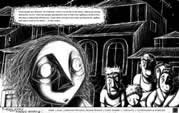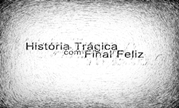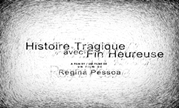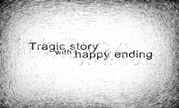Pixel Article
The technique of engraving animation on plates of plaster is not a common technique, it is not an easy technique, nor is it an advisable technique! But it does allow unparalleled results.
I didn’t know if the method that I used would be the most effective. The technique cropped up in my life somewhat accidentally, resulting from a series of coincidences and the development of various factors. When I first thought of the story for the film, I never imagined that I would end up using such a technique, nor did I even know it was possible.
It is important, sometimes, to work with the notion that there are no pre-established formulas or frontiers, and it is beneficial to keep your mind open to new ideas. Leaving a certain margin of creative freedom can have the most positive results, and surprise us wit unexpected solutions which almost always enrich our story. There are many way of using animation techniques, which can be even larger and more wide-ranging than the boundaries of our imagination.
To give you an idea of how things can change, I initially thought about making the film with Czech marionettes. We got to the stage of building sets and marionettes, and even filming a sort of pilot!
So, I will try to explain here that it was more the result of personal research into the “recipe” or “formula” to decide on the technique to use. Maybe if I had been another person, I would have taken this route and arrived at a very different result!
The idea
Having a strong and clear idea is essential.
In my case, it all started in a training course in France, during which every one of the students was asked to write a script. I found this a bit difficult at the time, because I had come from a Fine Arts background - I wasn’t used to writing stories. Well, I followed the advice of director Abi Feijo, one of the course tutors, who said to me “If you think you have something to say, trust in yourself, fight for it. If it is really important for you, dedicate yourself passionately to it and this will show through in the end result. The people who come to see the film will feel it as well, in some way.”
It was the most important lesson that that I learned in my life, and I tried to follow it. That’s how the story came about for “A Noite”.
If the story that we want to tell is important to us, it will help us through all the stages of making a film. Working in animation demands a great financial and personal investment, almost always involving periods of great monotony and anguish and it is tiring work, sometimes lasting several years. It is essential for the idea to be sufficiently strong to help us to cope with all the difficult moments and in this case, this strength was felt.
The importance of the Storyboard
The characters had always been very clear to me, right from the start, and I didn’t need to make a lot of studies for them. But when they are not very clear, and particularly if we know that we will be dividing the work with a team, we have to carefully study the characters from all angles and when “posing”, so that nobody has any doubts.
However, I did need to make a Storyboard, and to do so I used a pencil which was at hand, which by pure chance was Burnt Carmine. It forced me to transmit to each drawing the emotion that I was aiming for, and as a result, it gave major emphasis to the expression of the characters, to the texture and to the play of light and shadows. I was aware that I was dealing with a very simple story and that I lived in the environment and the drama that I wanted to transmit, in a visual and sound treatment.
I tried to make the storyboard as detailed and clear as possible, because that would enable me to resolve the doubts that might arise at various levels – doubts about camera position, about the framing, narrative continuity, agreement between the different plans, the drawings, etc.
In addition, it is necessary to be pragmatic and to bear in mind that it is essential to find financing for our films. With a good storyboard, it should be much easier to convince someone to invest in us.
When it was finished, I had a very coherent combination, a strong ambience, and a very attractive drawing, with the right colour, texture, and a very interesting interplay of light and shade. With regard to the visual side of the film, it started to appear much more interesting than the one we had made with the puppets. I had found a technique that respected the visual sense.
Therefore, the storyboard revealed itself to be a fundamental tool, and it was the storyboard that chose the technique.
The Research
Because of its texture and its atmosphere, my drawings made me vaguely recall the film “Kafka” by Piotr Dumala, which I had seen some years earlier. I had been told was that he had worked with plaster, but I didn’t know how, and at the time I didn’t try to find out. Then, later, I did some personal research and before I got to the technique that I finally used, I tried various methods with different materials and various paints and tools. My objective was to try to find a method that would respect the drawings on my storyboard.
After these attempts, many of them frustrating, I finally got interesting result, which not only respected my drawings, particularly with its potential for texture and the play of light and shade, it also increased the drama and the poetry. This was the atmosphere I had been looking for.
I felt assured that I knew that it would be possible to animate my pictures in this material. I made a test of the animation process, and I was happy with the results. I had found the technique!
The Plates
The plaster plate has to be made some time in advance, so it can be left for about a week until it is thoroughly dry. Therefore, to make use of our time, and because it is a lengthy process, the more plates that can be made, the better.
We must study in advance the framing that we are going to use for each plan so that we can work out the dimensions of the plates we are going to make. We also need to make a plan of all the frames. Of course, there are several frames that we are still not sure how to make, but these ones we leave until the end.
Once the dimensions are known, we have to build a wooden framework for each plate, simple but solid, because the plaster is breakable and this will give it some strength.
To ensure that the surface of the plaster ends up perfectly smooth, it is made under glass. But before that, we have to smear the whole surface with a fine film of Vaseline. This will make the surface of the plaster waterproof when we start to work it, stopping it from becoming absorbent. If not, the paint with which we will later cover the plate will taint the plaster, and it is essential to keep the contrast between the white of the plaster and the dark of the paint.
Next, place the wooden framework over the glass and fix it down well with adhesive tape, to prevent any involuntary movement during the process.
When it reaches the height of the first plaster layer, that is where we will work later. Put a bit of water in the bottom of a bucket and let the powdered plaster fall into the water, little by little, without mixing it, taking care that the powder is distributed across the surface of the water. If this is done as it should be, the plaster will naturally sink into the water, and build up at the bottom of the bucket. Stop dropping the powdered plaster in when the water is just saturated.
At that time, shake the bucket quickly so that the plaster doesn’t harden, mix the plaster thoroughly with the water (preferably by hand) so that it doesn’t have any lumps, and spread the mixture around the inside of the framework while it is still liquid. Leave the whole thing for five minutes. Firstly, this will prevent air bubbles forming, and, secondly my experience showed me that this gives it a uniformity that will make it easier to work with the paint and the animation later.
The amounts of water and plaster depend on the size of the plate that we want to make. The plaster to be used is normal plaster, which can be brought at any hardware store. The thickness of the first layer of plaster must not be very thick, because it will have to have another layer on top, which we will start to prepare while the first one is hardening. We will also prepare, at the same time, some strips of sisal fibres.
When the second plaster mixture is ready, mixed up in the same way as the first, put it on the sisal strips, getting it well into the liquid plaster, and place it on top of the first layer. The sisal, together with the plaster, will add strength to the plate as well as some flexibility, minimising the risk of the plate breaking. When everything has properly hardened (after an hour or more) remove the adhesive tape, separate the plate from the glass and let it dry, which can take up to a week, sometimes. If the weather is good, it can be left to dry in the open air, which will make it dry more quickly.
The painting.
Now, after having done the research and having chosen the type of paint that is most appropriate for the surface and for the animation, we will have to make a great amount of this paint, so that it will last throughout the whole of the film. We must not run the risk that the paint runs out half way through the production, but we can run the risk of a change in colour, particularly because the paint is made by mixing various different colours.
In my case, I used gouache of various colours to get the shade I wanted, diluted with water.
I was concerned about ensuring a strong texture. So, once the plaster plate was thoroughly dry, I took a very rough piece of sandpaper and gave it an irregular texture in all directions, across the whole surface of the plate.
After that, I painted the whole surface with the paint that I had made such a great quantity of, using a large brush to spread the paint in an even fashion. After it was dry (which takes half an hour to an hour), the plate was ready to take the first drawing.
The first drawing
Before making out first design, we need to have studied the picture that we want to make, to know the framing to use, to know its duration, and to have an idea of the animation that will be carried out. To do this, we make early studies of the scenery and the characters in their roles. This makes it easier to make the drawing on the plaster plate, which will have been lightly dampened with its water on its surface, with the help of a vaporiser. After that, put the paper study on top of the plate and trace the design with a pen or pencil, using a fair amount of force, so that the tracing comes through perfectly onto the plate.
Then you can start to work on the design, scratching it with the help of a stylus, a blade or an X-acto knife, with greater or lesser pressure (but always smoothly, there is no need to “dig deep”), depending on whether you are trying to get lighter or darker areas. Anyone using this technique really must not be a beginner and needs to have some experience in painting or design, and later on, they will develop their own personal style. I really believe that everybody will find the tools that are most suitable for their style. If we make a mistake, or if we want to obtain more nuanced pictures, we can correct that particular area with the help of a small paintbrush and paint, diluted with water to a greater or lesser extent.
The ideal size for these plaster plates to do this sort of work is around 38 cm by 30 cm, on average. Because the texture is strong and the material and the tools used are quite primitive, if the plate is made very small, it becomes a lot harder to work, and particularly to put in the details, but on the other hand, it does have the advantage of a smaller surface area, which means less work, and in some situations this can be an advantage. If the surface is very large, it will take a lot more work and a lot more time to get each image, but it does make it possible to work on small details, if this is important. Taking these points into account, we will reach the proper balance for each individual situation.
To scratch the surface of the plate to make the drawing, make sure you have a lot of powder, which will cover the whole of the design. However, it can get stuck to the lens of the camera during filming. To avoid this, whenever we work on a drawing, we always need to have a mini fan to hand. When we are working on this drawing, the paint has to be built up, and when it is damp, it has a different colour from when it is dry. Also, particularly during the filming, we also need to keep a hairdryer to hand, in order that the paint can be rapidly dried so that the image can be filmed. In addition, it is very difficult to work on the surface when the paint is damp.
The drawing is finished when we are happy with the result.
The filming
The next step will be to put the plate with the first drawing under the camera in order to start filming. The filming location must be well insulated from light, and the walls must be covered with curtains or painted black, so that there are no “parasite” reflections. You need to be equipped with a trolley that allows the camera to be moved. The plate must then be well fixed to the base, and screwed down, if possible. We can not run the risk that there might be any movement of the plate during filming.
The lighting is done with two spotlights placed at a 45 degree angle, one on each side of the plate. The capture of the images can be done with any camera that allows a single frame to be taken at a time. Treat it as a direct technique, which demands a lot of work, to ensure that the images captured are secure and of the best possible quality. In my case, I use a 35 mm camera (an old Debrie Parvo) to take the final images. Alongside it, I fix a video camera, connected to a betacam recorder, with a system that allows me to take a single frame at a time, and a video monitor. This equipment is not used for the final images, it is just used for video assistance and every time an image is taken on the 35 mm camera, it is also recorded on video. I use a betacam recorder because I was lucky enough to have that option. It was an advantage, because it allowed me to have the visual assistance of a good image quality, but we can also use a simpler system, preferably one that allows us to take individual images, and then we follow the same procedure set out above.
This video assistance system turned out to be an essential tool in my work, because it didn’t just let me do all the animation at any time, it also allowed me to compare the drawing which I have done with the previous one, which helped me to keep the correct features and proportions of the characters. It also allowed me to use the monitor to design trajectories and calculate the space between every two drawings and thereby get the best timing and expression for each movement. Without this equipment, I would be working “blind”, and I would have to wait for the film to be returned from the laboratory, which in this case could have taken months. It was too great a risk, because there could have been mistakes or other problems, and I would have had to start again from the beginning.
Engraving on plates is a direct technique, that is, when a drawing is ready, we film it and then destroy it, because its place is taken by a new design. At the end, there is only one remaining image on a plaster plate, the last one that was filmed.
I treated it as a slightly experimental technique, and I didn’t really know what to expect. I started working on animation with very simple plans, and from the start, the results were very encouraging. But when I started to do more complex designs, the work became more laborious and time consuming, and using the method that I developed to the technique, I found out that I got better results the more time I spent on it, which obviously required me to spend more time on each drawing. In the most simple situations, it was not necessary to destroy every design, for example if the character just moves an arm, it is only necessary to redraw that part of the plate and the rest can stay intact. But when the whole character moves over a period of time, then it is necessary to redraw the whole design in such a way that it does not show any alteration other than the movement desired.
When a plan is very complex, we can make some key designs on paper, which help to define the movement. This is again done with video assistance, and with a permanent marker to make notes on the monitor screen showing the trajectories of the movement we are looking for. Using this video, we can see what we are doing, which makes it easy to modify the design of the plate, taking the notes on the screen as a reference. After making the appropriate alterations, I can compare them with the design that I made for the final engraving, and I can check to see that I am on the right road, or make any necessary small corrections.
To get an idea of what I have done, and to prevent any fault creeping in, all the images that I film are recorded in “exhibition folders” (or timelines), where the number of the photographs that correspond to the camera counter number are noted. This is very useful, especially taking into account the monotony of the work, when it can be impossible to remember if a particular design has been filmed or not. If that happens, we can consult the exhibition folder and clear up any doubt. The exhibition folders are essential in situations in which it is essential to have synchronicity between the sound and the image, and when the camera movements have been made manually and the necessary calculations have not been exact. These folders relate to the animation in the same was that sheet music relates to music.
Now, with a bit of perspective, we can make a more studied analysis about the work as a whole, and about its advantages and disadvantages.
The biggest problem with this technique is the time demanded for the work and the production, which throw off any estimates and induce a great physical and emotional fatigue.
But it is marvellous to see an end result that started off as just an idea, and little by little has become real. It is important to make sure that the motivation that we felt at the start does not ever disappear, despite the difficult moments and the passage of a great deal of time, sometimes years, and to make sure that our initial idea proved itself to be sufficiently strong, that it help up, and that we can recognise the final result.






